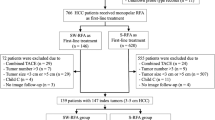Abstract
Purpose
Radiofrequency (RF) ablation with mono- or bipolar electrodes is a common procedure for hepatocellular carcinoma (HCC) with a low rate of recurrence for small size tumors. For larger lesions and/or non-round/ellipsoid shapes RF ablation has some limitations and generally does not achieve comparable success rates to microwave ablation or high-intensity focused ultrasound therapies.
Materials and methods
To shape RF ablations for matching a tumor size and geometry, we have developed an electronic channel switch box for two bipolar needles that generates multiple selectable ablation patterns. The setup can be used with commercially available mono- or bipolar RF generators. The switch box provides ten selectable ablation procedures to generate different ablation patterns without a relocation of a needle. Five patterns were exemplary generated in ex vivo tissue of porcine liver and chicken breast and visually characterized.
Results
Different ablation patterns, e.g., in a L- or U-shape, were achieved. In chicken breast a maximum ablation with a diameter of \(4.3\, \hbox {cm}\) was obtained and in porcine liver \(2.8\, \hbox {cm}\) with electrodes of \(0.9\, \hbox {cm}\) length.
Conclusion
The resulting ablations with the electronic switch box and two bipolar needles show the potential ability to manage RF therapies of complex and large tumor geometries. Next steps would be to validate the actual tissue ablation volumes in further ex vivo and preclinical studies and against simulation results.








Similar content being viewed by others
Change history
03 July 2018
The original version of this article was published without funding note. The funding note is given below.
References
Liu H, Wang Z-G, Fu S-Y, Li A-J, Pan Z-Y, Zhou W-P, Lau W-Y, Wu M-C (2016) Randomized clinical trial of chemoembolization plus radiofrequency ablation versus partial hepatectomy for hepatocellular carcinoma within the Milan criteria. Br J Surg 103:348–356
Potretzke TA, Ziemlewicz TJ, Hinshaw JL, Lubner MG, Wells SA, Brace CL, Agarwal P, Lee FT (2016) Microwave versus radiofrequency ablation treatment for hepatocellular carcinoma: a comparison of efficacy at a single center. J Vasc Interv Radiol 27:631–638
Kuenzli BM, Abitabile P, Maurer CA (2011) Radiofrequency ablation of liver tumors: actual limitations and potential solutions in the future. World J Hepatol 3:8–14
Proschek D, Tonak M, Zangos S, Mack M, Kurth A (2012) Radiofrequency ablation in experimental bone metastases using a controlled and navigated ablation device. J Bone Oncol 1:63–66
Mulier S, Jiang Y, Wang C, Jamart J, Marchal G, Michel L, Ni Y (2012) Bipolar radiofrequency ablation with four electrodes: ex vivo liver experiments and finite element method analysis. Influence of inter-electrode distance on coagulation size and geometry. Int J Hyperth 28:686–697
Wong K-P, Lang BH-H (2013) Use of radiofrequency ablation in benign thyroid nodules: a literature review and updates. Int J Endocrinol 2013, Article ID 428363
Goldberg SN (2001) Radiofrequency tumor ablation: principles and techniques. Eur J Ultrasound 13:129–147
Strasberg S, Linehan D (2003) Radiofrequency ablation of liver tumors. Curr Probl Surg 40:459–498
Minami Y, Kudo M (2011) Radiofrequency ablation of hepatocellular carcinoma: a literature review. International J Hepatol 2011, Article ID 104685
Minami Y, Kudo M (2013) radiofrequency ablation of liver metastases from colorectal cancer: a literature review. Gut Liver 7(1):1–6
Ferras LL, Ford NJ, Morgado ML, Nobrega JM, Rebelo MS (2015) Fractional Pennes bioheat equation: theoretical and numerical studies. Fract Calc Appl Anal 18:1080–1106
Facciorusso A, Serviddio G, Muscatiello N (2016) Local ablative treatments for hepatocellular carcinoma: an updated review. World J Gastrointest Pharmacol Ther 7:477
Hinshaw JL, Lubner MG, Ziemlewicz TJ, Lee FT Jr, Brace CL (2014) Percutaneous tumor ablation tools: microwave, radiofrequency, or cryoablation what should you use and why? Radiogr Radiolog Soc N Am 34:1344–1362
Rathke H, Hamm B, Gttler F, Rathke J, Rump J, Teichgrber U, de Bucourt M (2014) Comparison of four radiofrequency ablation systems at two target volumes in an ex vivo bovine liver model. Diagn Interv Radiol 20:251
Bitsch RG, Duex M, Helmberger T, Lubienski A (2006) Effects of vascular perfusion on coagulation size in radiofrequency ablation of ex vivo perfused bovine livers. Invest Radiol 41:422–427
Mikhail AS, Negussie AH, Graham C, Mathew M, Wood BJ, Partanen A (2016) Evaluation of a tissue-mimicking thermochromic phantom for radiofrequency ablation. Med Phys 43:4304–4311
Negussie AH, Partanen A, Mikhail AS, Xu S, Abi-Jaoudeh N, Maruvada S, Wood BJ (2016) Thermochromic tissue-mimicking phantom for optimisation of thermal tumour ablation. Int J Hyperth 32:239–243
Audigier C, Mansi T, Delingette H, Rapaka S, Mihalef V, Carnegie D, Boctor EM, Choti M, Kamen A, Ayache N, Comaniciu D (2015) Efficient lattice Boltzmann solver for patient-specific radiofrequency ablation of hepatic tumors. IEEE Trans Med Imaging 34:1576–1589
Kim Y, Audigier C, Dillow A, Cheng A, Boctor EM (2017) Speed of sound estimation for thermal monitoring using an active ultrasound element during liver ablation therapy (conference presentation). Medical imaging 2017: ultrasonic imaging and tomography. In Proceedings 10139:101390F
Acknowledgements
Equipment for this study was partly provided by the Olympus Winter & Ibe GmbH of the Olympus Surgical Technologies Europe.
Author information
Authors and Affiliations
Corresponding author
Ethics declarations
Conflict of Interest
The authors declare that they have no conflict of interest.
Human and animal rights
This article does not contain any studies with human participants or animals performed by any of the authors. This article does not contain patient data.
Rights and permissions
About this article
Cite this article
Ziegle, J., Audigier, C., Krug, J. et al. RF-ablation pattern shaping employing switching channels of dual bipolar needle electrodes: ex vivo results. Int J CARS 13, 905–916 (2018). https://doi.org/10.1007/s11548-018-1769-8
Received:
Accepted:
Published:
Issue Date:
DOI: https://doi.org/10.1007/s11548-018-1769-8




